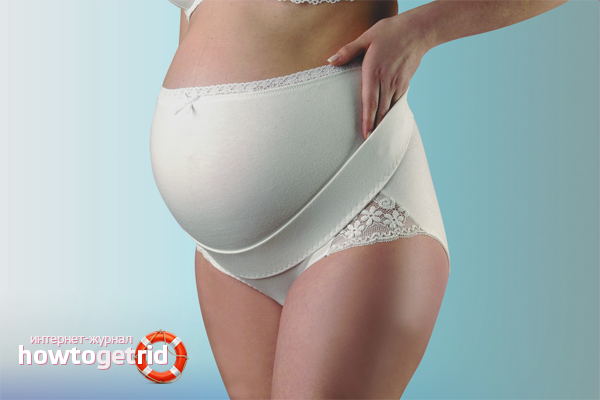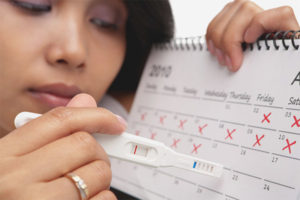The content of the article
The most important thing during pregnancy is maintaining the health of the expectant mother and baby. For these purposes, doctors and orthopedists have developed a prenatal bandage. It helps a pregnant woman feel comfortable, despite a growing tummy, especially if she leads an active lifestyle. Many mothers believe that the prenatal bandage causes inconvenience to the baby, limits its mobility. If you doubt the appropriateness of the application, consult with an obstetrician-gynecologist who will dispel all myths.
Do I need to wear a bandage
Antenatal bandage should be worn by all pregnant women in order to prevent the development of many diseases associated with a load on the spine and abdominal organs.
First of all, it is recommended in the following cases:
- Working pregnant women whose activities are associated with a long stay on their feet.
- When pain in the lumbar region.
- With osteochondrosis.
- With varicose veins on the legs.
- With edema.
- With multiple pregnancy.
- In the second and subsequent pregnancies.
- With the threat of premature birth.
- If there is a scar on the uterus.
- With polyhydramnios.
- With a large size of the uterus or fetus.
- With a low location of the placenta.
Also, the bandage helps preserve the beauty of the expectant mother, as it significantly reduces the load on the muscles and skin of the abdomen, preventing their stretching. Women noted the absence of striae on the skin and the quick return of the press to its previous shape.
Where to buy a bandage
Today, prenatal bandages can be bought at the pharmacy, in any store of goods for children and expectant mothers, and through the Internet. With such a variety, it is worth paying attention to proven outlets and avoiding dubious ones (markets, tents).
It is best to buy a bandage at the pharmacy, as the pharmacist has a medical background and will help you make the right choice. He will answer all questions and explain how to wear so that it is comfortable for you and the unborn baby.
On the other hand, in a pharmacy, unlike a store, you will not have the opportunity to fully try on a product. If you make a mistake with the size, then this product is not subject to exchange and return. When trying on a bandage, focus on your feelings. First of all, it should not cause discomfort and tightly squeeze the stomach.
Bandages for antenatal and postpartum are also sold in online stores. You run the risk of ordering an inaccurate size, getting low-quality goods, and you will not be able to try on the ordered model. Therefore, the acquisition through the World Wide Web should be abandoned. Also avoid buying from your hands or borrowing from girlfriends.
How to choose a bandage
The obstetrician-gynecologist will have to measure the volume of the hips and abdomen and say the exact size. Usually it has the same row as the clothes you wear, that is, S (42-44), M (44-46), L (46-48).
Tips for choosing a bandage:
- Pay attention to the material from which the product is sewn. It must be natural and breathable so that the skin can breathe.
- Most bandages are fixed with Velcro, so their quality is no less important. They should hold tight, but not be too hard, otherwise they will rub on contact with the skin.
- The bandage should not constrain movements so that you can freely sit, walk, climb stairs. Therefore, during the fitting, go around the store and evaluate your feelings.
- In the case when overweight appeared along with pregnancy, then choosing a product is worth a size larger than the one you wear in ordinary life.
- Do not stop at the first model you like, measure 3-4 options and choose the one you like most.
After purchasing a bandage, the doctor conducting your pregnancy will show you how to wear it and tell you whether the size is right.
Types of bandages
Today, manufacturers produce three main types of antenatal bandages. They differ not only in appearance.
Types of antenatal bandages:
- Panties. They are panties, elongated from above, that tighten the stomach with an elastic tape sewn in the thigh area and repeating the contours of the abdomen. Bandages-panties are made without seams and are most comfortable to wear. Since they are an element of underwear, it is worth stocking up with 2-3 models per shift.
- Belt. This is an option that can be worn under or on top of clothing. It looks like a wide elastic band with Velcro flaps sewn in at the edges and in the lower abdomen. Such a bandage is easy to precisely “tune” to your anatomical features.
- Universal. Most often, women give preference to him. Outwardly, it looks like a bandage belt, but with the only difference that during pregnancy it supports the tummy, and after that it helps to recover the uterus and other internal organs of the abdominal cavity. Such a product is recommended for those who have strongly stretched abdominal muscles during the period of gestation.
Try on each of the options and choose for yourself comfortable.
How to wear a bandage
In order for the bandage to help the expectant mother reduce the load on the spine, you need to be able to wear it correctly and know in which cases you can wear and in which not.
Recommendations of obstetricians:
- It is necessary to start wearing from the 22nd week of pregnancy, if there are no contraindications (incorrect presentation of the fetus);
- The first time the bandage should be worn by a doctor who will adjust it to your parameters. Listen carefully to his recommendations;
- Always wear the product in a prone position, so it will repeat the curves of your body as much as possible and will lie comfortably for you and the baby;
- The elastic tape should pass along the hips so that it goes under the stomach and is fixed on the area of the pubic bone;
- The bandage should not be dragged heavily. When walking or sitting, he will put pressure on his hips and abdomen;
- Do not carry the product for more than three hours in a row. Be sure to take breaks for 45-60 minutes;
- If the baby begins to push hard, you should immediately remove the product, also be sure to remove it while you sleep;
- Wear a universal bandage and a bandage-belt on linen to avoid rubbing.
Follow these rules, and wearing a bandage will give you comfort and pleasure.
How to care for the product
Add the detergent to warm water, stir by hand and soak the bandage. If there is severe contamination, then rub them with a brush. After washing, rinse thoroughly, gently wring out and leave to dry on a towel when unfolded.
Remember, the time when to start wearing a bandage should be determined only by a doctor. He will evaluate the state of health of the pregnant woman, whether the future mother has any contraindications, and will tell you how to determine the right size.
Video: bandage for pregnant women - how to wear, which one to choose










Submit